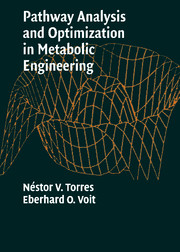Book contents
- Frontmatter
- Contents
- Preface
- 1 Target: A Useful Model
- 2 Methods of Biochemical Systems Theory
- 3 A Model of Citric Acid Production in the Mold Aspergillus niger
- 4 Optimization Methods
- 5 Optimization of Biochemical Systems
- 6 Optimization of Citric Acid Production in Aspergillus niger
- 7 Maximization of Ethanol Production in Saccharomyces cerevisiae
- 8 Conclusions
- Author Index
- Subject Index
- Plate section
- References
3 - A Model of Citric Acid Production in the Mold Aspergillus niger
Published online by Cambridge University Press: 28 July 2009
- Frontmatter
- Contents
- Preface
- 1 Target: A Useful Model
- 2 Methods of Biochemical Systems Theory
- 3 A Model of Citric Acid Production in the Mold Aspergillus niger
- 4 Optimization Methods
- 5 Optimization of Biochemical Systems
- 6 Optimization of Citric Acid Production in Aspergillus niger
- 7 Maximization of Ethanol Production in Saccharomyces cerevisiae
- 8 Conclusions
- Author Index
- Subject Index
- Plate section
- References
Summary
INTRODUCTION
This chapter addresses the question of how mathematical modeling can use detailed and localized biochemical information to deepen our understanding of biological functioning at the level of integrated metabolic pathways. It describes the cyclical process of mathematical modeling with the example of citric acid metabolism in Aspergillus niger. This system has some nice features that facilitate mathematical analysis and provide a good example for demonstrating the various steps of model design, analysis, and refinement. Although citric acid metabolism is quite complex and involves several biochemical pathways in two different cellular compartments, the system is relatively closed. Moreover, under conditions where A. niger synthesizes citric acid, this synthesis is essentially the only metabolic pathway of quantitative importance, the substrate is almost entirely glucose and/or fructose, and citric acid is the sole final product. The system is rich in external and internal controls, and the governing biochemical mechanisms are well documented with a comprehensive body of kinetic information. The intricate regulatory structure is a source of nonlinear responses that make nonmathematical approaches unsuitable.
Citric acid production in A. niger was first approached with mathematical modeling techniques by Meyrath (1967). He used a macroscopic approach based on mass and energy balances and concluded that up to 85% of the consumed hexoses could be converted into citric acid. Verhoff and Spradlin (1976) also presented a mass balance model with the aim of unraveling the metabolic pathways involved in citric acid biosynthesis.
Information
- Type
- Chapter
- Information
- Pathway Analysis and Optimization in Metabolic Engineering , pp. 75 - 133Publisher: Cambridge University PressPrint publication year: 2002
References
Accessibility standard: Unknown
Why this information is here
This section outlines the accessibility features of this content - including support for screen readers, full keyboard navigation and high-contrast display options. This may not be relevant for you.Accessibility Information
- 1
- Cited by
